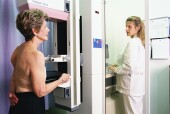 |
 |
 |

Breast CT Scans Could Be Comfortable Alternative to Mammograms
Newer technique didn't squeeze breasts, still spotted lesions, study finds|
|
HealthDay
Friday, August 1, 2008
 FRIDAY, Aug. 1 (HealthDay News) -- For women who find traditional mammograms painful, new research suggests there may one day be a more comfortable alternative.
FRIDAY, Aug. 1 (HealthDay News) -- For women who find traditional mammograms painful, new research suggests there may one day be a more comfortable alternative.
Breast CT scans showed some advantages over traditional mammograms, said study author John Boone, vice chairman of radiology at the University of California Davis Medical Center. He presented the findings this week at the American Association of Physicists in Medicine annual meeting, in Houston.
"Breast cancer shows up on a mammogram or imaging in two different ways -- a mass lesion or a spot," Boone explained. These spots are called microcalcifications, and they can signal the beginnings of a tumor.
In the CT breast exam, the scanner rotates around the breast to create a three-dimensional picture of the breast. The total radiation dose in the scan Boone used is the same as in a conventional mammogram, he said. In this study, 160 women were screened this way.
But the breasts are not compressed between plates, as in a traditional mammogram. Instead, the woman lies face down on a special table with one breast suspended through an opening.
"We feel the breast CT was superior to traditional mammography for mass lesions, but mammography remains superior over breast CT for microcalcifications," he said.
Several other centers are also studying breast CT, he noted. The role of breast CT is evolving, Boone said, and will depend on continuing research and how it bears out.
In his research, Boone and his colleagues have also began to study another prototype device which incorporates a positron emission tomography (PET) scanner into the CT scanner. The PET scanner can track the metabolic activity of a tumor, if present, so doctors can pinpoint the tumor and evaluate the effect of treatment.
Breast CT scans may be widely available in three to five years, Boone predicted.
The technology is experimental, cautioned Robert Smith, director of cancer screening for the American Cancer Society. "One of the things that is appealing is comfort on the part of the patient," he said.
But, he added, if it is going to play a role in breast imaging, "it has to be just as accurate in finding breast cancer [as mammography], and should not generate a higher rate of false positives."
In other presentations at the meeting, University of Wisconsin researchers reported on improvements in tools to make a procedure called modulated electron therapy (MERT) more effective in treating tumors of the chest wall after mastectomy.
And University of Chicago researchers discussed a new automated computer image analysis technique that better characterizes and diagnoses early breast cancers. The computer program makes use of facts known about how lesions respond to injected contrast agents to help doctors describe the lesion's characteristics. For instance, malignant lesions wash out contrast material more quickly than benign ones.
HealthDay
Copyright (c) 2008 ScoutNews, LLC. All rights reserved.
Related News:
More News on this Date
Related MedlinePlus Pages:
| Home | Health Topics | Drugs & Supplements | Encyclopedia | Dictionary | News | Directories | Other Resources | |
| Disclaimers | Copyright | Privacy | Accessibility | Quality Guidelines U.S. National Library of Medicine, 8600 Rockville Pike, Bethesda, MD 20894 National Institutes of Health | Department of Health & Human Services |
Date last updated: 04 August 2008 |




